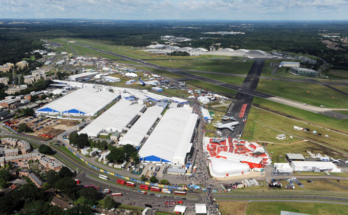By Richard Pettibone, Aerospace & Defense Companies Analyst, Forecast International.
China’s dream of becoming a major aerospace power took a step closer to becoming reality with the long-awaited rollout of the C919. This all-new narrowbody airliner is designed to compete directly against Airbus’ A320 family and Boeing’s 737.
Led by AVIC’s COMAC subsidiary, the program is now entering the difficult phase of testing, certification and delivery. It’s true that AVIC may have gained experience through the long-delayed ARJ21 regional jet program, but even Airbus, Boeing, and Bombardier have trouble keeping to aggressive schedules with all-new aircraft. Testing and certificating the C919 is going to be a long, drawn-out process, and service entry in the Chinese market is unlikely to occur until 2018 or later.
Nevertheless, the program is a milestone for AVIC and for China. One advantage the C919 program possesses versus Western competitors is that it is largely insulated from the financial pressures placed on Western manufacturers. The Chinese government wants to build an indigenous capability to produce airliners competitive with those built by Western manufacturers, and the program will therefore continue for as long as the Chinese government wants it to, regardless of whether the aircraft racks up major sales from airlines outside China.
Looking to its next project, AVIC, in collaboration with Russia’s UAC, is in the early stages of developing a 300-seat widebody aircraft called the C929. The program is very preliminary but shows just how serious China is about becoming a third player in the commercial aerospace market.
As AVIC continues to develop itself as a manufacturer, it is pursuing an ambitious mandate to restructure China’s aviation industry into a model that more closely resembles its Western counterparts. Gone are the old regional entities, replaced with a framework of units each specializing in a particular airframe component.
Perhaps most importantly, AVIC is recognizing its limitations, such as a lack of experience, aviation talent, and infrastructure. As AVIC seeks to become more of a developer than a duplicator, the need for outside technical acumen becomes acute. To fill these gaps, the firm is forming teaming arrangements or acquiring the necessary acumen to be successful.
The company has successfully teamed with Western manufacturers such as Bombardier, Parker Aerospace, and Safran to help educate its operations. Not only do these partnerships help in the here and now, but they also plant the seeds for future collaboration. And it is this long view that guides AVIC’s strategy as it labors through the growing pains of aircraft development.
In addition, the company has complemented and expanded its international footprint with acquisitions. So far, the company has purchased Fischer Advanced Composite Components and Thielert in Europe and made four acquisitions in the United States: Continental Motors, Epic Air, Cirrus Aircraft, and, most recently, Align Aerospace.
The acquisition of these enterprises is of major importance to AVIC, as they provide the firm with access to advanced foreign technologies that can be exploited under China’s well-established civil-military integration strategy. The company is targeting small to midsize operations with technological capabilities in the commercial aerospace sector. These skills will be leveraged into the firm’s current civil aircraft programs and then incorporated into military spheres.
This latter quest has caused some concern in the U.S., with AVIC’s deals being heavily scrutinized and criticized. While the deals were ultimately approved, Congress voiced concerns that AVIC would adapt some of the technologies for weapons systems and/or transfer work to China. China has made no secret that it is looking to improve its military technology, and sees the adoption of civil technology as a means to this end.
One area that has been weak for China’s aviation ambitions is aircraft engines. As a result, AVIC has been tasked by Beijing with restructuring its aero-engine holdings. A merger of AVIC Aviation Engine, Sichuan Chengfa Aero Science and Technology and AVIC Aero-Engine Controls is expected to form the foundation of a new engine business. The merger may also include Liyang Aero-Engine Corporation and the Liming Aero-Engine Manufacturing Corporation. Most telling is that the government may remove this new entity from AVIC’s control in an effort to cut bureaucracy and speed program development.
China is aggressively marketing AVIC on the world stage as well. Reports from air shows indicate that AVIC has stepped up its marketing savvy and aims to be an intense competitor. The company has begun packaging its message in a slick and sophisticated presentation, as evidenced by its current website (www.avic.com) – which is a marked departure from the awkward media relations of old.
A military history enthusiast, Richard began at Forecast International as editor of the World Weapons Weekly newsletter. As the Internet grew in importance as a research tool, he helped design the company's Forecast Intelligence Center and currently coordinates the EMarket Alert newsletters for clients. Richard also manages social media efforts, including two new blogs: Defense & Security Monitor, covering defense systems and international issues, and Flight Plan, which focuses on commercial aviation and space systems. For over 30 years, Richard has authored the Defense & Aerospace Companies, Volume I (North America) and Volume II (International) services. The two books provide detailed data on major aerospace and defense contractors. He also edits the International Contractors service, a database that tracks all the contractors involved in the programs covered in the FI library. More recently he was appointed Manager, Information Services Group (ISG), a new unit that encompasses developing outbound content for both Forecast International and Military Periscope.




